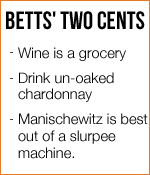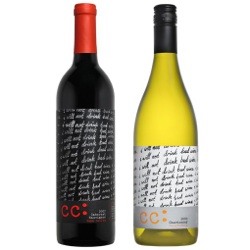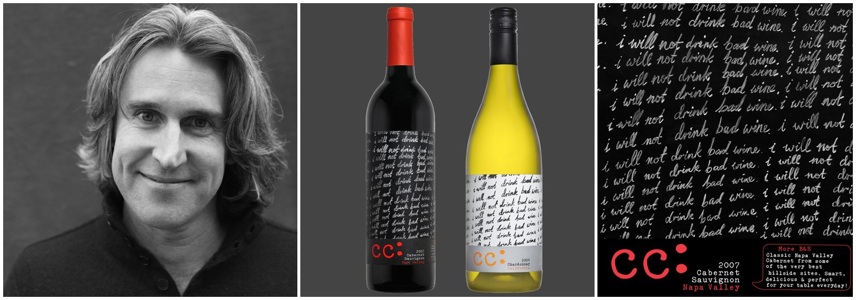Richard Betts, Master Sommelier, Winemaker, Mezcal Producer, Betts & Scholl, CC: Wine, Sobra Mezcal, Oaxaca, Recommendations, What to drink, Wines to recommend, Favorite Wine, Where to eat in France, Mexico, United States, New York, San Francisco, Dallas, Lyon, Seattle, Tucson, Aspen, Colorado, Arizona, California, Texas, Washington, WA, Cabernet, Chardonnay, Hermitage, Barossa Valley, Syrah, Cali, Burgundy, Dujac, Wine Collection, Twitter, Yobetts
Who
Richard Betts is a Master Sommelier, winemaker, and mezcal producer.
Why
He’s passionate about wine and mezcal and is spreading the gospel of wine as a grocery item, not a luxury item.

Richard Betts on Wine
March 27, 2011

Q & A With Richard Betts

Q. Tell us about your new venture CC: wines.
A. When I learned to drink wine, I was screwing around in Europe. Wine came in a pitcher and you put it in a tumbler. The table is not set unless the wine is on the table. It is fundamental to the whole experience and that is really what I am chasing here. We thought, let’s create a grocery.
Chardonnay and cabernet are synonymous for ‘I’ll have a glass of white’ and ‘I’ll have a glass of red’ when it comes to American wine drinking. For me, I want to affect change in people’s habits. My most lofty ambition is to enable people to drink wine all the time.
We launched CC: wines in late October [2010] and it’s going crazy. It’s kind of scary actually, but it’s exciting.

A. We are not the first to produce a chardonnay with no wood, but I am definitely promoting that as what I think is important for chardonnay in California. So, it’s a little bit of a wink and nod to that. We are going to take this buttery thing and make it bracing, make it yummy.
We could do it in the Mâconnais and we might still, but California is great for exactly what it can give us -- an abundance of sunshine. It’s fruit forward, but it also has great acidity. To me, it’s like a little bit riesling, a little bit sauvignon blanc, but it’s chardonnay. It makes you want to keep on eating and drinking, that’s the whole point... it’s meant for the table.
Q. And the cabernet?
A. California cabernet became this outsized, foolish thing with Orange County mortgages and trophy wines and foolish cars and now, those guys are in the weeds. It was an opportunity for us. Because of that, the winemakers can do one of two things: mark it down or you pretend like it still sells out, keep it at the same high price, and then just sell it in bulk out the back door to me. We get to give this whole adjustment and say that the wine is worth $20. It’s our little jab at the genre.
Q. Will the wine taste different from vintage to vintage?
A. No, they’ll be different in as much as wines differ from vintage to vintage. Each vintage will not be a gross departure from another. If you take 10 years of Caymus, the signature will be Napa Valley, American oak, you’ll taste that dill element through the whole thing, but just like the natural rhythm of any wine, there’ll be fluctuations in fruit and tannins based on the weather of the vintage.

A. I got drunk in Miami. I woke up in my hotel room and I thought: ‘I won’t drink bad wine.’ Just like when I was a kid, it was my penance: ‘I won’t drink bad wine... I won’t drink bad wine....’ That was the moment. The wine label is actually a photograph of the blackboard in the office where someone had to write it a hundred times. But I am old enough to have to have done that in school.
Q. So what would you eat with the chardonnay?
A. Anything and nothing. I would drop it in the river and catch fish and pull it out when it’s cold. Probably not red meat, for sure, but shellfish would be great, sushi would be great, a taco would be great. Maybe not a beef taco, but an Al Pastor could be fun, with the pineapple on the top.
Ultimately, I think the wine is quite flexible because of a little more acid than normal for California and the lack of oak, which just gets in the way.
Q. It seems like chardonnay is the gateway wine?
A. Exactly. Once you get them in the door, people will start exploring and branch out. Growing up, wine in my house was in a box in the fridge, next to the 7-Up.
Q. Wine in a box is coming back...
A. It is coming back... bravo. They are figuring out the technology to make it work, so that it doesn’t go bad in the bag. That’s great, wine in kegs is great. I think that is really fun.
Q. Who else is doing creative things in the wine world?
A. Certainly my partner Charles Bieler. I think Charles is singlehandedly responsible for the rosé craze in America. I think he deserves 90% of the credit. To say that anybody deserves 90% of anything in the wine business is a big statement. Take yourself back to what rosé was in the late 1990’s in America: white zinfandel. And nobody was thinking about it, except for Charles, who was in a pink tuxedo and had a pink Cadillac and was driving their family’s dry Cotes de Provence rosé across America - that’s huge. He’s forward thinking and amazing. He’s also the first guy with kegs. The Gotham Project Riesling is his thing and it’s huge.
I think Charles Smith is doing some interesting things in Washington State. His wines are great; the packaging is great; it speaks to the masses. To call a wine Kung Fu Girl, good for him, it’s awesome. I think he could extend that to sake.
It’s funny, some of them have been fads that have now fallen hard on their face. Like Australia... the whole critter label thing. I totally relished seeing that crash hard.
I think some of the guys in Austria and Burgundy are really impressive. Guys in places where there’s really intense history. In Austria there was the scandal and it’s exactly what the Austrian wine industry needed to let the young energy get in there. Nigl, for me, is just the guy.
Burgundy could have sat on its haunches and some guys still do and it’s so disappointing to drive around see these buildings and all the little communes you drive through... and they make shitty wine. At the same time, you have these young guys that are doing amazing work. Jacques Seysses, who’s now handed it on to Jeremy at Domaine Dujac, bought his domaine in Burgundy in the late 1960’s and made it one of the top five domaines in the world. Ben Leroux, too. There’s an endless list of these young guys who thought that what they had was good, but wanted to make it great. Instead of being lazy and sitting on their hands, they wanted to do it right.
Q. What about Australia?
A. Australia is amazing; they have done such a bad job of talking about what they have. You only hear that it’s cheap, cheerful, has a critter on the label, and it’s juicy and black. Their wine regions are so geographically diverse, but they only talk about one thing. I’m not singing that same song. Our [Betts & Scholl] Barossa Valley grenache is from an 88 year old grenache vineyard that grows in deep, deep sand and it sees only old French oak. The youngest barrel is ten years old - at that point the barrels have nothing to say really.
Q. Do you use real cork for all your wines that are under cork?
A. Yes, we don’t use synthetic corks. I think that that robs it of something. I think it takes something out of it.
Q. Your CC: Chardonnay has a screw cap, do you think there’s an image problem with the screw cap when it comes to wine?
A. Totally, I think there are different levels of it. It’s not as bad as it used to be, but there are people who are afraid because they think it means they are being cheap. They may also have a perception that the wine’s not of the same quality.
I was in Dallas at a place called Tei-An Soba House, which I totally recommend for their amazing Japanese food. It’s really great, very elegant, really sweet people. There was a Thierry & Pascal Matrot 2007 Meursault on the list and I was stoked, ‘I’ll kill that with sushi.’ When it came out, it had a screw cap on it. I was mad for a second. Meursualt is not supposed to have a screw cap on it, it’s $90! The screw cap totally changed my whole perception of it. It went from being Meursault with this beautiful fish to ‘fuck it, that’s what we’re going to chase the tequila with now.’ I thought about myself having all the same prejudices that I beat people up about having. I was a victim of everything that I complain about. But, it’s real. Meursault from a grower I really like for $100 and a screw cap... no, I am not down with that. The CC: wine for $13 dollars with a screw cap... great.
Q. With Betts & Scholl, you used to make a California Syrah?
A. I believe that California is a great place for syrah and grenache. We had a couple hundred cases a year with Randy and Debbie Lewis. From 2004 through 2007, we split a tank of syrah grapes from the Hudson vineyard in Carneros, with 2006 being particularly special. We’d do long vinification, like the Northern Rhone. I put it in old chardonnay barrels -- that was a really cool thing. When I first smelled one of the chardonnay barrels, it just smelled like flowers. It was beautiful. It was our ode to Cornas with a little polish. I could put it in a blind tasting with a Cornas and nobody would tell the difference.
Advice / Tips

Q. At what temperature do you enjoy your wine?
A. You don’t want the wine too cold. Unless you don’t like the wine, in which case you should put it in the ice bucket or just put it in the slurpee machine. We used to do that with the Manischewitz at the Seder dinner at The Little Nell.
Recommendations

FIND...
Q. What are some great resources for people that want to learn more about wine?
A. My book - I am writing a book. I am doing a scratch-n-sniff approach to wine expertise. It is going to be a 20-page board book and you’ll be able to scratch-n-sniff yourself to being way smarter.
I walk you through what is fruit in a wine, what is earth in a wine, what is wood in a wine, as well as the faults and floral components. I help you identify what red fruits smell like, what black fruits smell like, which do you prefer? In the book, it’s easy, there’s a flow chart. You’ll be able to say that you like the red fruits, the funky-earthy thing and the American oak thing and you’d know that you should be drinking traditional Rioja tonight. It’ll be that easy.
Q. Any other resources that you like?
A. The Guild of Sommeliers website is amazing. It’s an offshoot of the Court of Master Sommeliers. I am one [a Master Sommelier] and I’m on the board, so full disclosure here. The Court of Master Sommeliers is a non-profit organization, which means unfortunately their best work happens in a very narrow bandwidth. The Guild of Sommeliers has every resource you could hope for.
Secrets of the Sommeliers by Raj Parr is amazing, I would totally recommend this book. It’s a really nice profile of people, of why wine matters, how people got emotional about it, and different producers.
Twitter is great, if you follow the right people.
[See details.]
Q. Who are you following on Twitter that you like?
A. I really like Eric Asimov (@ericasimov) a lot, I like Jon Bonne (@jbonne), Thomas Matthews (@trmatthews), the executive editor of the Wine Spectator, is interesting. It’s not so much that they give you nuggets in 140 characters, but they give you links or they give you thought and threads to follow-up on.
I follow HipHopDX (@HipHopDX) to figure out what I should be buying in the record store.
Eat...
Q. What wine bars / restaurants around the country are you loving?
New York, NY
A. The Ten Bells deserves some play. Everyone knows and loves Terroir, but Ten Bells is very cool and super authentic. The whole scene can get a little gritty... there’s no pretense. There is none of the snottiness that can come with wine sometimes.
Michael Madrigale at Bar Boulud is amazing. Pour it all out of magnum... why not... fuck it. I love it. Michael is so passionate about wine, that’s the key.
Angel’s Share - it’s worth going for the cocktails and for Johnny’s Tofu.
Bohemian is amazing. I’ve become a regular; I’m a huge fan. I go almost every trip. And the space is amazing -- there’s real moss growing in there.
[See details.]
Brooklyn, NY
Brooklyn Fare - it’s the best meal I’ve had this year, including everything in France. Cesar Ramirez is the chef and it’s like a horseshoe seating arrangement with 14 seats. You go there and it puts you in a whole other state. Just be there, because it is great.
[See details.]
Boulder, CO
Frasca all the time, it’s great. I’m super amped to try their new pizzeria.
Basta is a pizzeria that is amazing, but very hard to find. It’s in The Peloton building in East Boulder. Kelly Whitaker, who had worked in Los Angeles, is making amazing pizza. I’d put it up against any of the Neapolitan style pizzas in New York.
The Kitchen is great. They have a real commitment to the community and to the farmers.
OAK at fourteenth is a new place, which was opened by some Frasca alum doing their thing around wood burning ovens. It’s really good. Sit at the chef’s table, which is a bar in front of two hearths. Chef Steven [Redzikowski] worked at The French Laundry and The Little Nell so you’d think he’d make something very fancy, it’s not at all. Chicken under a brick, right there in the fire, is very good.
Amu [Izakaya Amu] is my favorite place in Boulder. It’s about six seats at the bar and a tatami table in the back. You’re in there with some other colorful characters in town, like the Japanese track coaches. It’s Japanese street food: fermented seaweed, etc. and it’s really special.
[See details.]
Aspen, CO
The Little Nell is actually the best thing there. There’s a whole stigma about hotel restaurants, but they also have the means and the ability to do it right. They do it really, really well. Right now, they are doing it the best they ever have because of chef Ryan Hardy. He’s amazing. Ryan owns a farm. He moved to Aspen and bought a farm in Paonia (about an hour and a half away). He has pigs, chickens, eggs. The veggies are all his and he’s a really skilled pasta maker. He gets food in a very simple way... he’s not fussy.
Cache Cache Bistro has been there for almost 20 years now and it’s super.
Matsuhisa is great and cranks.
[See details.]
Q. Any off the beaten track local places in Aspen?
A. Little Annie’s isn’t really a secret anymore. But for off the beaten track, you kind of have to go down valley -- if you are willing to take a trip.
In Woody Creek, Woody Creek Tavern for really great Mexican.
In Basalt, El Korita. A really delicious Shrimp Ceviche done Korita style is way spicy and way delish!
There aren’t really too many secrets in Aspen, it’s more about where’s the secret powder stash.
[See details.]
Austin, TX
In Austin there are so many good eats. I do really like drinking wine outside at the Paggi House. Sommelier Chris McFall has done an amazing job of putting together a smart and fun list.
[See details.]
Dallas, TX
Tei-An Soba House, which I totally recommend for their amazing Japanese food, it’s really great, very elegant, really sweet people.
[See details.]
Seattle, WA
Bar Ferd’nand is a wine bar in Seattle that I went to at Thanksgiving right across from Sitka & Spruce, which is owned by the guys who own The Corson Building. So those are my three favorite related restaurants in the country right now. They are amazing. You go there and drink Occhipinti (super honest stuff). It’s so unassuming, but so cool and basic and perfect and it’s in an old industrial hanger of some variety and there is a great cheesemonger and a great butcher and a great florist and this little wine bar with six stools and a bar with a tiny little retail outlet. Sitka & Spruce is the restaurant that holds it all together at the end. Marc Papineau runs it and has all these awesome soulful wines. There’s no attitude and no pretense. He’s there to tell you all about the wines, with love and a smile.
[See details.]
San Francisco, CA
RN74 is probably the most fantastic thing in the country. It’s super legit. You can drink incredible stuff there by the glass. And you have Raj Parr...and you have everyone that wants to work for Raj Parr. Raj has some of the best sommeliers in the country working for him.
[See details.]
Los Angeles, CA
LaMill Coffee Boutique in the Silver Lake section of Los Angeles.
[See details.]
Tucson, AZ
The Mexican food is amazing. Mariscos Chihuahua - but you have to eat at the one on Grande [North Grande Avenue]. They have several now, but the one on Grande is the deal. They have this amazing abalone that’s sliced paper thin with cucumber, a little red onion and a lime. It’s amazing. You drink Micheladas. A Mexican beer cocktail with chili, Worcestershire sauce, salt, pepper, lots of lime, crushed ice, salt rimmed glass and a beer, which has to be Tecate in a can, that you pour right over the top. It’s sort of Bloody Mary-esque. It is really limey, it can be clammy, and it’s really great. With cold fish when it’s a 110 degrees out, it’s pretty nice.
El Mezon Del Cobre is another great spot.
Everybody writes about Cafe Poca Cosa which is great, but the little one, Little Cafe Poca Cosa, is better than the big one. It’s owned by her sister, who is really wild, and lives in Mexico and rides her motorcycle up and is crazy. It used to be right next to the Federal Courthouse in a tiny space, but after 9/11 they made her move because she was too close to the courthouse. It’s breakfast and lunch only.
[See details.]
Lyon, France
In Hermitage, when I’d do harvest there and get a day off, you go to Lyon and go to a place called Les Halles -- it’s where all the chefs shop, Bocuse’s sous-chefs will be there. You do your shopping and you eat oysters at Merle. They have these amazing little shrimp in the shell and you dip them in aioli. It’s one of my favorite little spots. You have late breakfast there. And you drink these pots (pitchers) of cold Macon (un-oaked chardonnay). The guys who work there are always really surly, but it adds to the whole character of it.
[See details.]
Drink...
Q. Do you collect any wines?
A. I do, I collect friends. I am a big believer that every vintage is good for something and this is a business of relationships. The Chaves are going to be lifelong friends, as are the Seysses family of Dujac. In both cases the friendship preceded the work together, but we have a business arrangement with both of them. We own a little vineyard in Burgundy, which was born out of this friendship.
[See details.]
Q. It helps that they are exceptional wine makers in exceptional places.
A. Totally.
Recommendations

Details of Richard Bett’s recommendations for where to eat and drink around the United States, in France and Mexico, as well as where to research wine and who to follow on Twitter.
Master Sommelier, Winemaker, & Mezcal Producer
General Information

CC: Wine
Wine
California Chardonnay and Cabernet
Website:
Betts & Scholl
Wine
France, Australia, California
Website:
Sombra
Mezcal
Oaxaca
Website:


Share

Twitter





Wine


Share
























